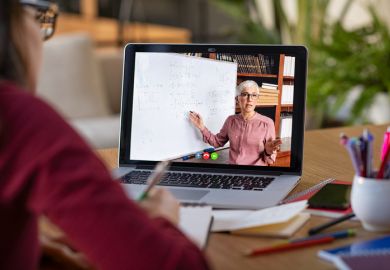It goes without saying that the Covid-19 pandemic has brought a range of challenges to universities. And one that has affected both staff and students hugely is the transition to online. Notwithstanding the need to enhance technological infrastructure and provision, one of the ongoing issues for staff appears to be how we present ourselves in online sessions.
With the mass adoption of video-conferencing software for live online sessions, many discussions have arisen about topics that simply did not exist before. Should camera functions be turned on or off? Should a virtual background be used? Is it acceptable to show up to online sessions in your pyjamas? All these issues revolve around the central premise of self-presentation, which refers to our efforts in presenting ourselves to others.
Sociologist Erving Goffman devised a theory of self-presentation (sometimes referred to as “impression management”) suggesting that in the presence of others, we perform to present our best selves and work to avoid “giving off” signals that are unfavourable.
In face-to-face interactions, where there is a high level of demand to monitor both verbal and non-verbal behaviours, our self-presentational efforts can be rather high. Online communication is often discussed as an easier platform for this, as many interactions are text-based and asynchronous, resulting in them generally being less demanding of effort to manage one’s presentation to others.
How to build outstanding pedagogy for teaching via Zoom
Of course, this is not the case in online live sessions. Online video conferencing is the closest replica we have of real-world, face-to-face interaction. With this in mind, we would expect similar, or perhaps even higher, levels of effort in self-presentation to those for our usual face-to-face interactions.
Indeed, many have observed that we can be rather fatigued after these video calls, which goes some way to suggest that we have additional self-presentational efforts to address in these settings, more so even than during their face-to-face equivalents.
One reason for this may be that most video-calling platforms will include the user’s own camera view on the call screen. It is likely that this enhances our self-awareness to a greater level than usual and results in us making more self-presentational efforts than we would in face-to-face interactions in the real world.
A second explanation for fatigue may simply be due to technical restrictions and our inability to use the usual array of social cues and non-verbal communication. Within video calls, the bandwidth of social cues is much narrower, and we have to pay additional attention to others’ behaviour to enable us to monitor social interactions effectively. These extra attentional efforts can become tiring over time.
However, opportunities may come from these live online sessions, too. One is that they allow us to engage in a wider range of multimodal communication. In an online session, not only may both verbal and non-verbal communication be available but chat functions in video-conferencing software can allow text and even multimedia content to be shared. This has the potential to widen the communication bandwidth and also encourage different ways of interacting and engaging in online sessions.
Multimedia such as emojis or gifs are often discussed as being a form of hyper-personal communication which compensate for the absence of non-verbal cues in communication.
A vastly developing field of research focusing on the uses and functions of emojis highlights their potential not only in supporting emotional clarity but also in aiding social processing and even identity presentation.
These, as well as other available “cues”, such as visible home environment, which might not be present in classroom settings, may encourage a different set of social dynamics and relations among tutors and students.
From lecture theatre to living room: adapting teaching techniques to the online classroom
This may in some cases help break down typically perceived hierarchies, encourage openness and foster reciprocation and engagement in sessions that may be quite varied compared to our more traditional “real world” classroom teaching experiences.
Of course, not all live online sessions take the same format or are well suited to a wide range of modes for communication. Additionally, not all tutors and students are fully comfortable with all of these. However, with online teaching almost certain to become a more integrated and common feature in higher education provision in the coming years, it is critical that we place much importance on more fully understanding the social and educational implications of our online teaching methods and modalities.
Dr Linda Kaye is a cyberpsychology specialist in the department of psychology at Edge Hill University in Lancashire, England.
Register to continue
Why register?
- Registration is free and only takes a moment
- Once registered, you can read 3 articles a month
- Sign up for our newsletter
Subscribe
Or subscribe for unlimited access to:
- Unlimited access to news, views, insights & reviews
- Digital editions
- Digital access to THE’s university and college rankings analysis
Already registered or a current subscriber?




